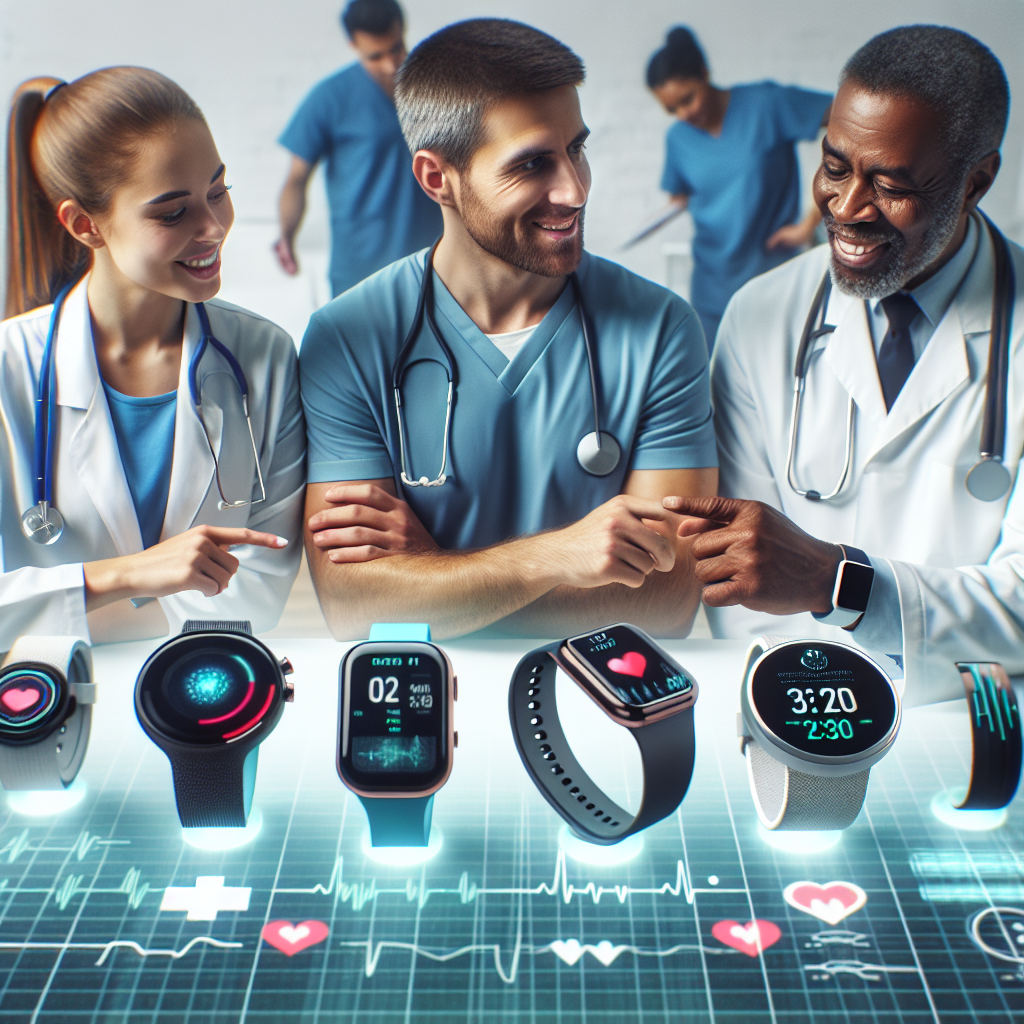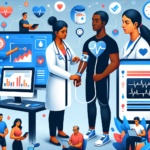-
Table of Contents
“Revolutionizing Health: The Power of Wearable Tech”
Introduction

Wearable technology has revolutionized various sectors, and healthcare is no exception. The integration of wearable devices in healthcare has opened new avenues for patient monitoring, disease management, and overall wellness. These devices, ranging from smartwatches to fitness trackers and advanced biosensors, offer real-time data collection and analysis, enabling proactive healthcare management. By continuously monitoring vital signs such as heart rate, blood pressure, and glucose levels, wearable tech provides valuable insights that can lead to early detection of potential health issues, personalized treatment plans, and improved patient outcomes. Additionally, the convenience and accessibility of wearable devices empower individuals to take an active role in their health, fostering a more engaged and health-conscious population. As technology continues to advance, the potential benefits of wearable tech in healthcare are vast, promising a future where healthcare is more efficient, personalized, and preventive.
Enhancing Patient Monitoring with Wearable Tech
In recent years, the integration of wearable technology into healthcare has revolutionized patient monitoring, offering unprecedented benefits that extend beyond traditional methods. As healthcare systems worldwide grapple with increasing demands and limited resources, wearable tech emerges as a beacon of hope, promising enhanced patient care and improved health outcomes. This transformation is not just a technological advancement but a compassionate response to the pressing needs of patients and healthcare providers alike.
One of the most significant advantages of wearable technology in healthcare is its ability to provide continuous, real-time monitoring of patients. Unlike conventional methods that rely on periodic check-ups and manual data collection, wearables such as smartwatches, fitness trackers, and specialized medical devices can track vital signs like heart rate, blood pressure, and glucose levels around the clock. This constant stream of data allows for early detection of potential health issues, enabling timely interventions that can prevent complications and even save lives. For instance, a patient with a history of cardiac problems can benefit immensely from a wearable device that alerts them and their healthcare provider to irregular heart rhythms, facilitating prompt medical attention.
Moreover, wearable technology empowers patients by giving them greater control over their health. By providing easy access to their own health data, these devices encourage individuals to take a proactive role in managing their conditions. This shift towards patient-centered care fosters a sense of responsibility and engagement, which is crucial for the effective management of chronic diseases such as diabetes and hypertension. Patients can monitor their progress, adhere to treatment plans more diligently, and make informed lifestyle choices that contribute to their overall well-being.
In addition to enhancing patient autonomy, wearable tech also alleviates the burden on healthcare professionals. With the ability to remotely monitor patients, doctors and nurses can focus their attention on those who need it most, optimizing resource allocation and improving the efficiency of healthcare delivery. This remote monitoring capability is particularly beneficial in rural or underserved areas where access to healthcare facilities may be limited. By bridging the gap between patients and providers, wearable technology ensures that quality care is accessible to all, regardless of geographical constraints.
Furthermore, the integration of wearable tech into healthcare systems facilitates better data management and analysis. The vast amounts of data generated by these devices can be harnessed to identify trends, predict outcomes, and tailor treatments to individual patients. This data-driven approach not only enhances the precision of medical care but also contributes to the advancement of medical research. By analyzing aggregated data from diverse populations, researchers can gain valuable insights into disease patterns, risk factors, and the effectiveness of various interventions, ultimately leading to more effective and personalized treatments.
However, the widespread adoption of wearable technology in healthcare is not without challenges. Concerns about data privacy and security must be addressed to ensure that sensitive health information is protected. Additionally, there is a need for standardized protocols and regulations to govern the use of these devices, ensuring their accuracy and reliability. Despite these hurdles, the potential benefits of wearable tech in healthcare are undeniable, and ongoing advancements in technology and policy are likely to overcome these obstacles.
In conclusion, wearable technology holds immense promise for enhancing patient monitoring and transforming healthcare delivery. By providing continuous, real-time data, empowering patients, alleviating the burden on healthcare professionals, and facilitating better data management, these devices are poised to revolutionize the way we approach health and wellness. As we navigate the complexities of integrating wearable tech into healthcare, it is essential to remain focused on the ultimate goal: improving patient outcomes and ensuring that everyone has access to the care they need.
Improving Chronic Disease Management through Wearable Devices
Wearable technology has revolutionized various aspects of our lives, but its impact on healthcare, particularly in managing chronic diseases, is nothing short of transformative. As chronic conditions like diabetes, hypertension, and heart disease continue to rise globally, the need for effective management tools has never been more critical. Wearable devices, ranging from smartwatches to fitness trackers, are stepping up to meet this challenge, offering a blend of convenience, real-time monitoring, and personalized care that traditional methods often lack.
One of the most significant advantages of wearable tech in chronic disease management is its ability to provide continuous monitoring. Unlike periodic check-ups, these devices offer a constant stream of data, allowing both patients and healthcare providers to keep a vigilant eye on vital signs. For instance, a person with diabetes can use a wearable glucose monitor to track blood sugar levels throughout the day. This real-time data can alert the user to any dangerous spikes or drops, enabling immediate corrective action and reducing the risk of severe complications.
Moreover, the integration of wearable devices with mobile apps and cloud-based platforms facilitates seamless data sharing between patients and healthcare providers. This connectivity ensures that doctors have access to up-to-date information, which can be crucial for making timely and accurate treatment decisions. For example, a cardiologist can monitor a patient’s heart rate variability through data transmitted from a smartwatch, allowing for early detection of potential issues and adjustments to treatment plans as needed.
In addition to real-time monitoring, wearable tech also empowers patients by promoting self-management and accountability. Many devices come equipped with features that encourage users to take an active role in their health. Reminders to take medication, prompts to engage in physical activity, and notifications to maintain hydration levels are just a few examples of how these devices can support healthier lifestyles. This proactive approach not only helps in managing the chronic condition but also fosters a sense of control and responsibility in patients, which is often crucial for long-term adherence to treatment plans.
Furthermore, the data collected by wearable devices can be invaluable for research and development in the healthcare sector. Aggregated and anonymized data sets can provide insights into disease patterns, treatment efficacy, and patient behavior, contributing to more effective and personalized healthcare solutions. Researchers can analyze trends and correlations that were previously difficult to identify, paving the way for innovations in treatment and prevention strategies.
However, it is essential to acknowledge the challenges and limitations that come with the adoption of wearable tech in healthcare. Data privacy and security are paramount concerns, as the sensitive information collected by these devices must be protected from unauthorized access. Additionally, the accuracy of some wearable devices can vary, and not all patients may have the technological literacy required to use them effectively. Addressing these issues through robust security measures, user-friendly designs, and comprehensive education programs is crucial for maximizing the benefits of wearable tech in chronic disease management.
In conclusion, wearable technology holds immense promise for improving the management of chronic diseases. By offering continuous monitoring, facilitating data sharing, promoting self-management, and contributing to research, these devices are reshaping the landscape of healthcare. While challenges remain, the potential benefits far outweigh the drawbacks, making wearable tech a vital tool in the ongoing battle against chronic conditions. As technology continues to advance, the integration of wearable devices into healthcare systems will likely become even more seamless and impactful, offering hope and improved quality of life for millions of patients worldwide.
Revolutionizing Fitness and Wellness with Wearable Health Tech
Wearable technology has become an integral part of modern healthcare, revolutionizing the way individuals monitor their fitness and wellness. These devices, ranging from smartwatches to fitness trackers, have seamlessly integrated into daily life, offering a plethora of benefits that extend beyond mere step counting. As the adoption of wearable health tech continues to rise, it is essential to explore how these innovations are transforming fitness and wellness, providing users with unprecedented insights into their health.
One of the most significant advantages of wearable health tech is its ability to provide real-time data. This immediate feedback allows users to make informed decisions about their health and fitness routines. For instance, a smartwatch can monitor heart rate, track sleep patterns, and even measure blood oxygen levels. By having access to this data, individuals can identify potential health issues early and seek medical advice before they escalate into more serious conditions. This proactive approach to health management is a game-changer, empowering users to take control of their well-being.
Moreover, wearable health tech fosters a sense of accountability and motivation. Many devices come equipped with features that encourage users to set and achieve fitness goals. Whether it’s completing a certain number of steps per day or maintaining a consistent exercise routine, these devices provide gentle reminders and positive reinforcement. This can be particularly beneficial for those who struggle with maintaining motivation, as the constant feedback and progress tracking can serve as powerful incentives to stay active and healthy.
In addition to individual benefits, wearable health tech also has the potential to transform healthcare on a broader scale. By collecting vast amounts of health data, these devices can contribute to large-scale studies and research. This aggregated data can help healthcare professionals identify trends, understand the prevalence of certain conditions, and develop more effective treatment plans. Furthermore, the integration of wearable tech with telemedicine platforms allows for remote monitoring of patients, making healthcare more accessible and convenient, especially for those in remote or underserved areas.
However, it is important to acknowledge the challenges and limitations associated with wearable health tech. Privacy concerns are paramount, as the collection and storage of sensitive health data raise questions about data security and user consent. Ensuring that this information is protected and used ethically is crucial to maintaining user trust. Additionally, while wearable devices are becoming more advanced, they are not infallible. Inaccuracies in data collection can lead to misinterpretations and potentially harmful decisions. Therefore, it is essential for users to use these devices as supplementary tools rather than sole sources of health information.
Despite these challenges, the benefits of wearable health tech in revolutionizing fitness and wellness are undeniable. As technology continues to advance, these devices will likely become even more sophisticated, offering deeper insights and more accurate data. The integration of artificial intelligence and machine learning could further enhance their capabilities, providing personalized health recommendations based on individual data patterns.
In conclusion, wearable health tech is transforming the landscape of fitness and wellness, offering users real-time data, fostering motivation, and contributing to broader healthcare advancements. While challenges remain, the potential for these devices to improve individual health outcomes and revolutionize healthcare delivery is immense. As we continue to embrace these innovations, it is essential to navigate the associated challenges thoughtfully, ensuring that the benefits of wearable health tech are realized for all.
Conclusion
In conclusion, wearable technology in healthcare offers significant benefits, including continuous health monitoring, early detection of medical conditions, personalized treatment plans, and improved patient engagement. These devices can lead to better health outcomes, reduced healthcare costs, and enhanced efficiency in medical care. As technology advances, the integration of wearables in healthcare is likely to become more widespread, further transforming the landscape of medical practice and patient care.





